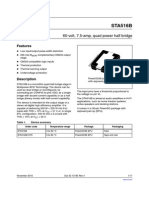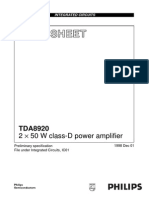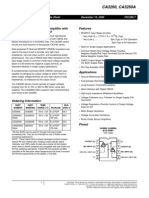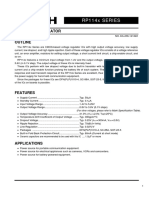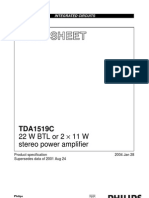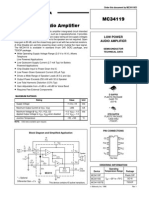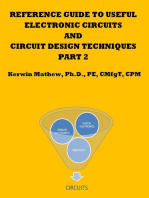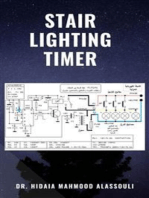TDA 6106q
TDA 6106q
Uploaded by
qwertyuiCopyright:
Available Formats
TDA 6106q
TDA 6106q
Uploaded by
qwertyuiCopyright
Available Formats
Share this document
Did you find this document useful?
Is this content inappropriate?
Copyright:
Available Formats
TDA 6106q
TDA 6106q
Uploaded by
qwertyuiCopyright:
Available Formats
INTEGRATED CIRCUITS
DATA SHEET
TDA6106Q Video output amplifier
Product specication File under Integrated Circuits, IC02 1997 Mar 03
Philips Semiconductors
Product specication
Video output amplier
FEATURES No external heatsink required Black current measurement output for Automatic Black current Stabilization (ABS) Internal 2.5 V reference circuit Internal protection against positive appearing CRT flashover discharges Single supply voltage of 200 V Simple application with a variety of colour decoders Controlled switch-off behaviour. ORDERING INFORMATION PACKAGE TYPE NUMBER NAME TDA6106Q BLOCK DIAGRAM DBS9MPF DESCRIPTION plastic DIL-bent-SIL medium power package with n; 9 leads GENERAL DESCRIPTION
TDA6106Q
The TDA6106Q is a monolithic video output amplifier with a 6 MHz bandwidth and is contained in a 9-lead plastic DIL-bent-SIL medium power package. The device uses high-voltage DMOS technology and is intended to drive the cathode of a CRT. To obtain maximum performance, the amplifier should be used with black current control.
VERSION SOT111-1
handbook, full pagewidth
supply voltage 6
feedback output 9
n.c. n.c. n.c.
1 2 7 MIRROR 1 in out 1 MIRROR 2 out 1 in 8 cathode output
Vbias
TDA6106Q
CURRENT SOURCE 5 black current measurement output
inverting input
DIFFERENTIAL + STAGE
out
out MIRROR 3
out
out
in gnd 4 ground (substrate)
MBG343
Fig.1 Block diagram.
1997 Mar 03
Philips Semiconductors
Product specication
Video output amplier
PINNING SYMBOL n.c. n.c. Vin GND Iom VDD n.c. Voc Vof PIN 1 2 3 4 5 6 7 8 9 DESCRIPTION not connected not connected inverting input voltage ground, substrate black current measurement output supply voltage not connected cathode output voltage feedback output voltage
handbook, halfpage
TDA6106Q
n.c. n.c. Vin GND Iom VDD n.c. Voc Vof
1 2 3 4 5 6 7 8 9
MBG342
TDA6106Q
Fig.2 Pin configuration.
LIMITING VALUES In accordance with the Absolute Maximum Rating System (IEC 134); voltages with respect to pin 4 (ground) unless otherwise specied; currents specied as in Fig.1. SYMBOL VDD Vin Vom Voc Vof Ioc(l) Ioc(h) Pmax Tstg Tj Vesd PARAMETER supply voltage inverting input voltage black current measurement output voltage cathode DC output voltage feedback output voltage low non-repetitive peak cathode output current high non-repetitive peak cathode output current maximum power dissipation storage temperature junction temperature electrostatic discharge note 3 note 4 Notes 1. The cathode output is protected against peak currents (caused by positive voltage peaks during high-resistance flash) of 5 A maximum with a charge content of 100 C. 2. The cathode output is also protected against peak currents (caused by positive voltage peaks during low-resistance flash) of 10 A maximum with a charge content of 100 nC. 3. Human body model: equivalent to discharging a 100 pF capacitor through a 1.5 k resistor. 4. Machine model: equivalent to discharging a 200 pF capacitor through a 0 resistor. ashover discharge = 100 C; note 1 ashover discharge = 100 nC; note 2 CONDITIONS 0 0 0 0 0 0 0 0 55 20 2000 300 MIN. 8 6 VDD VDD 5 10 tbf +150 +150 +2000 +300 MAX. 250 UNIT V V V V V A A W C C V V
1997 Mar 03
Philips Semiconductors
Product specication
Video output amplier
HANDLING
TDA6106Q
Inputs and outputs are protected against electrostatic discharge in normal handling. However, to be totally safe, it is desirable to take normal precautions appropriate to handling MOS devices (see Handling MOS Devices ). QUALITY SPECIFICATION Quality specification SNW-FQ-611 part E is applicable, except for ESD Human body model see Chapter Limiting values, and can be found in the Quality reference handbook (ordering number 9397 750 00192). THERMAL CHARACTERISTICS SYMBOL Rth j-a Rth j-c Note 1. External heatsink not required. CHARACTERISTICS Operating range: Tamb = 20 to +65 C; VDD = 180 to 210 V (see note 1), Vom = 1.4 to 6 V. Test conditions: Tamb = 25 C; VDD = 200 V; Vom = 4 V; CL = 10 pF (CL consists of parasitic and cathode capacitance); measured in test circuit of Fig.5; unless otherwise specied. SYMBOL IDD Ibias Vint Iom(os) PARAMETER quiescent voltage supply current input bias current (pin 3) offset current of black current measurement output temperature drift of internal reference voltage input stage linearity of current transfer CONDITIONS VocDC = 100 V VocDC = 100 V Ioc = 0 A; Vin = 1.5 to +3.5 V; Vom = 1.4 to 6 V VocDC = 100 V Ioc = 10 A to 3 mA; Vin = 1.5 to +3.5 V; Vom = 1.4 to 6 V Voc = 20 V to VDD 30 V Vin = 3.5 V Vin = 1.5 V f = 500 kHz; VocDC = 100 V VocAC = 60 V (p-p); VocDC = 100 V VocAC = 100 V (p-p); VocDC = 100 V 0 10 MIN. 2.8 2.5 0 TYP. 3.0 MAX. 3.3 20 +10 UNIT mA A V A PARAMETER(1) thermal resistance from junction to ambient in free air thermal resistance from junction to case VALUE 56 12 UNIT K/W K/W
internal reference voltage input stage VocDC = 100 V
VTint I om ---------- I oc Iof(max) Voc(min) Voc(max) GB BWS BWL
0.9
0.5 1.0
1.1
mV/K
maximum peak output current (pin 9) minimum output voltage (pin 8) maximum output voltage (pin 8) gain bandwidth product of open-loop gain Vos/Vi, dm small signal bandwidth large signal bandwidth
VDD 14 5 4.7
25 7 VDD 10 0.52 6 5.7
12
mA V V GHz MHz MHz
1997 Mar 03
Philips Semiconductors
Product specication
Video output amplier
TDA6106Q
SYMBOL tpd
PARAMETER cathode output propagation delay time 50% input to 50% output
CONDITIONS Voc = 50 to 150 V square wave; f < 1 MHz; trin = tn = 40 ns; see Figs 3 and 4 Voc = 50 to 150 V square wave; f < 1 MHz; tn = 40 ns; see Fig.4 38
MIN. 49
TYP.
MAX. 60
UNIT ns
tr
cathode output rise time 10% output to 90% output
62
74
87
ns
tf
cathode output fall time 90% output to Voc = 150 to 50 V square 10% output wave; f < 1 MHz; trin = 40 ns; see Fig.4 settling time 50% input to (99% < output < 101%) Voc = 50 to 150 V square wave; f < 1 MHz; trin = tn = 40 ns; see Figs 3 and 4 Vin = 2 V (p-p) square wave; f < 1 MHz; trin = tn = 40 ns Voc = 50 to 150 V square wave; f < 1 MHz; trin = tn = 40 ns; see Figs 3 and 4 f < 50 kHz; note 2
62
74
87
ns
ts
350
ns
SR
slew rate between 50 and 150 V
1200
V/s
OV
cathode output voltage overshoot
PSRR Notes
power supply rejection ratio
60
dB
1. The rating of supply voltage is 250 V, but because of flash the maximum operating range for supply voltage is 210 V. 2. PSSR: The ratio of the change in supply voltage to the change in input voltage when there is no change in output voltage.
1997 Mar 03
Philips Semiconductors
Product specication
Video output amplier
TDA6106Q
x Vi
0 t
x ts overshoot (in %) 150 140 149 151
Voc
100
60 50
t tr t pd
MGA974
Fig.3 Output voltage (pin 8 rising edge) as a function of AC input signal.
1997 Mar 03
Philips Semiconductors
Product specication
Video output amplier
TDA6106Q
x Vi
0 t
x ts
150 140 Voc 100 overshoot (in %) 51 60 50 49 t tf t pd
MGA975
Fig.4 Output voltage (pin 8 falling edge) as a function of AC input signal.
Flashover protection The TDA6106Q incorporates a protection diode against CRT flashover discharges that clamp the cathode output voltage to a maximum of VDD + Vdiode. To limit the diode current, an external 1.5 k carbon high-voltage resistor in series with the cathode output and a 2 kV spark gap are needed (for this resistor-value, the CRT has to be connected to the main PCB). This addition produces an increase in the rise and fall times of approximately 7.5 ns and a decrease in the overshoot of approximately 1.3%.
VDD to GND must be decoupled: 1. With a capacitor larger than 20 nF with good HF behaviour (e.g. foil). This capacitor must be placed as close as possible to pins 6 and 4, but definitely within 5 mm. 2. With a capacitor larger than10 F on the picture tube base print (shared by three output stages). Switch-off behaviour The output pins of the TDA6106Q are still under the control of the input pin for a supply voltage down to approximately 30 V.
1997 Mar 03
Philips Semiconductors
Product specication
Video output amplier
TEST AND APPLICATION INFORMATION
TDA6106Q
handbook, full pagewidth
Cpar Rfb C1 22 nF C2 22 F R9 866 R10 100 k 200 V
Vin
C6 100 nF
Cn 560 pF
6 R1 50 0.98 mA 3
TDA6106Q 8
4 5 C7 A Vom 4V 3.2 pF C8 6.8 pF C9 136 pF R3 20 M probe R2 1 M
GND
MBG344
Cpar = 150 fF.
Fig.5 Test circuit with feedback factor 1116. The dynamic dissipation equals: P dyn = V DD ( C L + C fb + C int ) f V o ( p p ) b Where: CL = load capacitance. Cfb = feedback capacitance. Cint = internal load capacitance ( 4 pF). f = input frequency. Vo(p-p) = output voltage (peak-to-peak value). b = non-blanking duty-cycle. The IC must be mounted on the picture tube base print to minimize the load capacitance (CL).
Dissipation With respect to dissipation, distinction must be made between static dissipation (independent of frequency) and dynamic dissipation (proportional to frequency). The static dissipation of the TDA6106Q is due to supply currents and load currents in the feedback network and CRT. P stat V of = V DD I DD + V oc I oc V of ------- R fb
Where: Rfb = value of feedback resistor. Ioc = DC value of cathode current.
1997 Mar 03
Philips Semiconductors
Product specication
Video output amplier
INTERNAL PIN CONFIGURATION
TDA6106Q
handbook, full pagewidth
GND 4
VDD 6
TDA6106Q
from input circuit esd esd esd from reference circuit Vbias 9 Vof
Vin
from input circuit esd
flash prot. from pin 9 from pin 9 esd from reference circuit 6.8 V esd flash prot. 8
Iom
Voc
to BCS-circuit output
MBG345
Fig.6 Internal pin configuration.
1997 Mar 03
Philips Semiconductors
Product specication
Video output amplier
PACKAGE OUTLINE DBS9MPF: plastic DIL-bent-SIL medium power package with fin; 9 leads
TDA6106Q
SOT111-1
D1 q P P1 Q A2
A3 q1 q2
A A4 seating plane pin 1 index
L 1 Z b2 e b b1 w M 9
e2
5 scale
10 mm
DIMENSIONS (mm are the original dimensions) UNIT mm A 18.5 17.8 A2 A3 max. 3.7 8.7 8.0 A4 b b1 b2 c D (1) D1 E (1) e e2 L 3.9 3.4 P 2.75 2.50 P1 3.4 3.2 Q q q1 4.4 4.2 q2 5.9 5.7 w 0.25 Z (1) max. 1.0
65o 55o
15.5 1.40 0.67 1.40 0.48 21.8 21.4 6.48 2.54 2.54 15.1 1.14 0.50 1.14 0.38 21.4 20.7 6.20
1.75 15.1 1.55 14.9
Note 1. Plastic or metal protrusions of 0.25 mm maximum per side are not included. OUTLINE VERSION SOT111-1 REFERENCES IEC JEDEC EIAJ EUROPEAN PROJECTION
ISSUE DATE 92-11-17 95-03-11
1997 Mar 03
10
Philips Semiconductors
Product specication
Video output amplier
SOLDERING Introduction There is no soldering method that is ideal for all IC packages. Wave soldering is often preferred when through-hole and surface mounted components are mixed on one printed-circuit board. However, wave soldering is not always suitable for surface mounted ICs, or for printed-circuits with high population densities. In these situations reflow soldering is often used. This text gives a very brief insight to a complex technology. A more in-depth account of soldering ICs can be found in our IC Package Databook (order code 9398 652 90011). Soldering by dipping or by wave The maximum permissible temperature of the solder is 260 C; solder at this temperature must not be in contact with the joint for more than 5 seconds. The total contact time of successive solder waves must not exceed 5 seconds. DEFINITIONS Data sheet status Objective specication Preliminary specication Product specication Limiting values
TDA6106Q
The device may be mounted up to the seating plane, but the temperature of the plastic body must not exceed the specified maximum storage temperature (Tstg max). If the printed-circuit board has been pre-heated, forced cooling may be necessary immediately after soldering to keep the temperature within the permissible limit. Repairing soldered joints Apply a low voltage soldering iron (less than 24 V) to the lead(s) of the package, below the seating plane or not more than 2 mm above it. If the temperature of the soldering iron bit is less than 300 C it may remain in contact for up to 10 seconds. If the bit temperature is between 300 and 400 C, contact may be up to 5 seconds.
This data sheet contains target or goal specications for product development. This data sheet contains preliminary data; supplementary data may be published later. This data sheet contains nal product specications.
Limiting values given are in accordance with the Absolute Maximum Rating System (IEC 134). Stress above one or more of the limiting values may cause permanent damage to the device. These are stress ratings only and operation of the device at these or at any other conditions above those given in the Characteristics sections of the specication is not implied. Exposure to limiting values for extended periods may affect device reliability. Application information Where application information is given, it is advisory and does not form part of the specication. LIFE SUPPORT APPLICATIONS These products are not designed for use in life support appliances, devices, or systems where malfunction of these products can reasonably be expected to result in personal injury. Philips customers using or selling these products for use in such applications do so at their own risk and agree to fully indemnify Philips for any damages resulting from such improper use or sale.
1997 Mar 03
11
Philips Semiconductors a worldwide company
Argentina: see South America Australia: 34 Waterloo Road, NORTH RYDE, NSW 2113, Tel. +61 2 9805 4455, Fax. +61 2 9805 4466 Austria: Computerstr. 6, A-1101 WIEN, P.O. Box 213, Tel. +43 1 60 101, Fax. +43 1 60 101 1210 Belarus: Hotel Minsk Business Center, Bld. 3, r. 1211, Volodarski Str. 6, 220050 MINSK, Tel. +375 172 200 733, Fax. +375 172 200 773 Belgium: see The Netherlands Brazil: see South America Bulgaria: Philips Bulgaria Ltd., Energoproject, 15th floor, 51 James Bourchier Blvd., 1407 SOFIA, Tel. +359 2 689 211, Fax. +359 2 689 102 Canada: PHILIPS SEMICONDUCTORS/COMPONENTS, Tel. +1 800 234 7381 China/Hong Kong: 501 Hong Kong Industrial Technology Centre, 72 Tat Chee Avenue, Kowloon Tong, HONG KONG, Tel. +852 2319 7888, Fax. +852 2319 7700 Colombia: see South America Czech Republic: see Austria Denmark: Prags Boulevard 80, PB 1919, DK-2300 COPENHAGEN S, Tel. +45 32 88 2636, Fax. +45 31 57 1949 Finland: Sinikalliontie 3, FIN-02630 ESPOO, Tel. +358 9 615800, Fax. +358 9 61580/xxx France: 4 Rue du Port-aux-Vins, BP317, 92156 SURESNES Cedex, Tel. +33 1 40 99 6161, Fax. +33 1 40 99 6427 Germany: Hammerbrookstrae 69, D-20097 HAMBURG, Tel. +49 40 23 53 60, Fax. +49 40 23 536 300 Greece: No. 15, 25th March Street, GR 17778 TAVROS/ATHENS, Tel. +30 1 4894 339/239, Fax. +30 1 4814 240 Hungary: see Austria India: Philips INDIA Ltd, Shivsagar Estate, A Block, Dr. Annie Besant Rd. Worli, MUMBAI 400 018, Tel. +91 22 4938 541, Fax. +91 22 4938 722 Indonesia: see Singapore Ireland: Newstead, Clonskeagh, DUBLIN 14, Tel. +353 1 7640 000, Fax. +353 1 7640 200 Israel: RAPAC Electronics, 7 Kehilat Saloniki St, TEL AVIV 61180, Tel. +972 3 645 0444, Fax. +972 3 649 1007 Italy: PHILIPS SEMICONDUCTORS, Piazza IV Novembre 3, 20124 MILANO, Tel. +39 2 6752 2531, Fax. +39 2 6752 2557 Japan: Philips Bldg 13-37, Kohnan 2-chome, Minato-ku, TOKYO 108, Tel. +81 3 3740 5130, Fax. +81 3 3740 5077 Korea: Philips House, 260-199 Itaewon-dong, Yongsan-ku, SEOUL, Tel. +82 2 709 1412, Fax. +82 2 709 1415 Malaysia: No. 76 Jalan Universiti, 46200 PETALING JAYA, SELANGOR, Tel. +60 3 750 5214, Fax. +60 3 757 4880 Mexico: 5900 Gateway East, Suite 200, EL PASO, TEXAS 79905, Tel. +9-5 800 234 7381 Middle East: see Italy Netherlands: Postbus 90050, 5600 PB EINDHOVEN, Bldg. VB, Tel. +31 40 27 82785, Fax. +31 40 27 88399 New Zealand: 2 Wagener Place, C.P.O. Box 1041, AUCKLAND, Tel. +64 9 849 4160, Fax. +64 9 849 7811 Norway: Box 1, Manglerud 0612, OSLO, Tel. +47 22 74 8000, Fax. +47 22 74 8341 Philippines: Philips Semiconductors Philippines Inc., 106 Valero St. Salcedo Village, P.O. Box 2108 MCC, MAKATI, Metro MANILA, Tel. +63 2 816 6380, Fax. +63 2 817 3474 Poland: Ul. Lukiska 10, PL 04-123 WARSZAWA, Tel. +48 22 612 2831, Fax. +48 22 612 2327 Portugal: see Spain Romania: see Italy Russia: Philips Russia, Ul. Usatcheva 35A, 119048 MOSCOW, Tel. +7 095 755 6918, Fax. +7 095 755 6919 Singapore: Lorong 1, Toa Payoh, SINGAPORE 1231, Tel. +65 350 2538, Fax. +65 251 6500 Slovakia: see Austria Slovenia: see Italy South Africa: S.A. PHILIPS Pty Ltd., 195-215 Main Road Martindale, 2092 JOHANNESBURG, P.O. Box 7430 Johannesburg 2000, Tel. +27 11 470 5911, Fax. +27 11 470 5494 South America: Rua do Rocio 220, 5th floor, Suite 51, 04552-903 So Paulo, SO PAULO - SP, Brazil, Tel. +55 11 821 2333, Fax. +55 11 829 1849 Spain: Balmes 22, 08007 BARCELONA, Tel. +34 3 301 6312, Fax. +34 3 301 4107 Sweden: Kottbygatan 7, Akalla, S-16485 STOCKHOLM, Tel. +46 8 632 2000, Fax. +46 8 632 2745 Switzerland: Allmendstrasse 140, CH-8027 ZRICH, Tel. +41 1 488 2686, Fax. +41 1 481 7730 Taiwan: Philips Semiconductors, 6F, No. 96, Chien Kuo N. Rd., Sec. 1, TAIPEI, Taiwan Tel. +886 2 2134 2870, Fax. +886 2 2134 2874 Thailand: PHILIPS ELECTRONICS (THAILAND) Ltd., 209/2 Sanpavuth-Bangna Road Prakanong, BANGKOK 10260, Tel. +66 2 745 4090, Fax. +66 2 398 0793 Turkey: Talatpasa Cad. No. 5, 80640 GLTEPE/ISTANBUL, Tel. +90 212 279 2770, Fax. +90 212 282 6707 Ukraine: PHILIPS UKRAINE, 4 Patrice Lumumba str., Building B, Floor 7, 252042 KIEV, Tel. +380 44 264 2776, Fax. +380 44 268 0461 United Kingdom: Philips Semiconductors Ltd., 276 Bath Road, Hayes, MIDDLESEX UB3 5BX, Tel. +44 181 730 5000, Fax. +44 181 754 8421 United States: 811 East Arques Avenue, SUNNYVALE, CA 94088-3409, Tel. +1 800 234 7381 Uruguay: see South America Vietnam: see Singapore Yugoslavia: PHILIPS, Trg N. Pasica 5/v, 11000 BEOGRAD, Tel. +381 11 625 344, Fax.+381 11 635 777
For all other countries apply to: Philips Semiconductors, Marketing & Sales Communications, Building BE-p, P.O. Box 218, 5600 MD EINDHOVEN, The Netherlands, Fax. +31 40 27 24825 Philips Electronics N.V. 1997
Internet: http://www.semiconductors.philips.com
SCA53
All rights are reserved. Reproduction in whole or in part is prohibited without the prior written consent of the copyright owner. The information presented in this document does not form part of any quotation or contract, is believed to be accurate and reliable and may be changed without notice. No liability will be accepted by the publisher for any consequence of its use. Publication thereof does not convey nor imply any license under patent- or other industrial or intellectual property rights.
Printed in The Netherlands
547047/1200/01/pp12
Date of release: 1997 Mar 03
Document order number:
9397 750 01869
You might also like
- Data Sheet: TDA6106QDocument13 pagesData Sheet: TDA6106Qban4444No ratings yet
- Tda 6103Document16 pagesTda 6103Ondrej LomjanskiNo ratings yet
- TDA6107QDocument16 pagesTDA6107QjosetantonioNo ratings yet
- 3 Video Ampop - Tda6107qDocument16 pages3 Video Ampop - Tda6107qAnderson LuizNo ratings yet
- IC-ON-LINE - CN dm0465r 44841Document20 pagesIC-ON-LINE - CN dm0465r 44841ubhagavanNo ratings yet
- TS921Document16 pagesTS921afsajghfdNo ratings yet
- Ir2153 2 PDFDocument9 pagesIr2153 2 PDFamijoski6051No ratings yet
- Linear Integrated Circuit: Low Frequency Power AmplifierDocument7 pagesLinear Integrated Circuit: Low Frequency Power AmplifierRenzo Fernandez HurtadoNo ratings yet
- TDA1557QDocument11 pagesTDA1557QLuiz FernandoNo ratings yet
- Datasheet Amp DVD Philips Dumbo PDFDocument17 pagesDatasheet Amp DVD Philips Dumbo PDFfreekenzoNo ratings yet
- TDA1554Q 44W Audio AmplifierDocument11 pagesTDA1554Q 44W Audio Amplifiersava7698No ratings yet
- Ir 2153Document9 pagesIr 2153Carlos Marinho SilvaNo ratings yet
- Ir 2153Document9 pagesIr 2153SteveAbonyiNo ratings yet
- IRS2092 DatasheetDocument18 pagesIRS2092 DatasheetSergio Daniel BarretoNo ratings yet
- Tda 1552 QDocument10 pagesTda 1552 QAnderson PotrikusNo ratings yet
- Data Sheet: TDA1558QDocument11 pagesData Sheet: TDA1558QMarco Tulio Da SilvaNo ratings yet
- DG 201Document9 pagesDG 201Brzata PticaNo ratings yet
- Tda8920 2x50w Rms Class D AmplifierDocument16 pagesTda8920 2x50w Rms Class D AmplifierMarcisio Souza0% (1)
- Data Sheet: TDA2653ADocument12 pagesData Sheet: TDA2653Ad_richard_dNo ratings yet
- Tpa3110d2 PDFDocument36 pagesTpa3110d2 PDFAndres AlegriaNo ratings yet
- Precision Phase-Locked Loop: ... The Analog Plus CompanyDocument21 pagesPrecision Phase-Locked Loop: ... The Analog Plus Companykao08No ratings yet
- 2.7V Dual Channel 12-Bit A/D Converter With SPI Serial InterfaceDocument34 pages2.7V Dual Channel 12-Bit A/D Converter With SPI Serial InterfaceManjunatha Ac100% (1)
- Tda8359 PDFDocument20 pagesTda8359 PDFsiliboyNo ratings yet
- Tda 2613 QDocument11 pagesTda 2613 Qpaulmx13No ratings yet
- Ca3260, Ca3260A: 4Mhz, Bimos Operational Amplifier With Mosfet Input/Cmos Output FeaturesDocument4 pagesCa3260, Ca3260A: 4Mhz, Bimos Operational Amplifier With Mosfet Input/Cmos Output FeaturesPaulo Cesar SimonettiNo ratings yet
- Quad Low Side Driver: DescriptionDocument17 pagesQuad Low Side Driver: DescriptionDan EsentherNo ratings yet
- Data Sheet: 2 X 6 W Stereo Car Radio Power AmplifierDocument10 pagesData Sheet: 2 X 6 W Stereo Car Radio Power Amplifierazzeddine_a7601No ratings yet
- TDA2003 BridgeDocument10 pagesTDA2003 BridgeMartinaxMgmNo ratings yet
- Tb62206Fg: Bicd PWM 2 Phase Bipolar Stepping Motor DriverDocument28 pagesTb62206Fg: Bicd PWM 2 Phase Bipolar Stepping Motor DriverLuis Alejandro Blanco CalvoNo ratings yet
- 74 Alvc 164245Document13 pages74 Alvc 164245roozbehxoxNo ratings yet
- Rp103X Series: Low Noise 150ma Ldo RegulatorDocument29 pagesRp103X Series: Low Noise 150ma Ldo RegulatorSol De GabrielNo ratings yet
- U708Document28 pagesU708Sol De GabrielNo ratings yet
- AZ324Document10 pagesAZ324Franklim Miranda Dos SantosNo ratings yet
- Description Features: CMOS Low-Power Monostable/Astable MultivibratorDocument15 pagesDescription Features: CMOS Low-Power Monostable/Astable Multivibratorதினேஷ் குமார்No ratings yet
- MC1648 DataSheetDocument11 pagesMC1648 DataSheetKWojtek100% (1)
- NCP4672 Dual Linear Voltage Regulators With V and V Voltage DetectorDocument8 pagesNCP4672 Dual Linear Voltage Regulators With V and V Voltage DetectorAlys AlysNo ratings yet
- Self-Oscillating Half-Bridge Driver: Ir2153 (D) (S) & (PBF)Document9 pagesSelf-Oscillating Half-Bridge Driver: Ir2153 (D) (S) & (PBF)Zoltán HalászNo ratings yet
- TDA 1519cDocument21 pagesTDA 1519cCris VMNo ratings yet
- Relay P14X DatasheetDocument24 pagesRelay P14X Datasheetaeqv12No ratings yet
- Max Power 43 W BTL × 4 CH Audio Power IC: FeaturesDocument12 pagesMax Power 43 W BTL × 4 CH Audio Power IC: FeaturesMiloud ChouguiNo ratings yet
- TC4420/TC4429: 6A High-Speed MOSFET DriversDocument22 pagesTC4420/TC4429: 6A High-Speed MOSFET DriverssophiaNo ratings yet
- Motorola MC34119DTBDocument13 pagesMotorola MC34119DTBsveta9733276No ratings yet
- Ucc 28220Document32 pagesUcc 28220urpublicNo ratings yet
- CA3102Document11 pagesCA3102bonaparteCWBNo ratings yet
- Ta8229 Sip Ic DatasheetDocument9 pagesTa8229 Sip Ic DatasheetNoliCatangoganSalcedoNo ratings yet
- TDA2050 - DatasheetDocument18 pagesTDA2050 - Datasheetnwo330No ratings yet
- Quad 2-Channel Analog Multiplexer / Demultiplexer: BU4551B / BU4551BF / BU4551BFVDocument6 pagesQuad 2-Channel Analog Multiplexer / Demultiplexer: BU4551B / BU4551BF / BU4551BFVmaldomattNo ratings yet
- Data Sheet: TDA1510AQDocument12 pagesData Sheet: TDA1510AQGerardo PonceNo ratings yet
- Reference Guide To Useful Electronic Circuits And Circuit Design Techniques - Part 1From EverandReference Guide To Useful Electronic Circuits And Circuit Design Techniques - Part 1Rating: 2.5 out of 5 stars2.5/5 (3)
- Reference Guide To Useful Electronic Circuits And Circuit Design Techniques - Part 2From EverandReference Guide To Useful Electronic Circuits And Circuit Design Techniques - Part 2No ratings yet
- Analog Dialogue Volume 46, Number 1: Analog Dialogue, #5From EverandAnalog Dialogue Volume 46, Number 1: Analog Dialogue, #5Rating: 5 out of 5 stars5/5 (1)
- Design of Electrical Circuits using Engineering Software ToolsFrom EverandDesign of Electrical Circuits using Engineering Software ToolsNo ratings yet
- Precision Waveform Generator/Voltage Controlled Oscillator FeaturesDocument10 pagesPrecision Waveform Generator/Voltage Controlled Oscillator FeaturesqwertyuiNo ratings yet
- 5130 XpressMusic RM-495 Schematics v1 0 PDFDocument0 pages5130 XpressMusic RM-495 Schematics v1 0 PDFCah NgaloefNo ratings yet
- TPC8016-H: High Speed and High Efficiency DC-DC Converters Notebook PC Applications Portable Equipment ApplicationsDocument7 pagesTPC8016-H: High Speed and High Efficiency DC-DC Converters Notebook PC Applications Portable Equipment ApplicationsqwertyuiNo ratings yet
- TL062 TL062A - TL062B: Low Power J-Fet Dual Operational AmplifiersDocument10 pagesTL062 TL062A - TL062B: Low Power J-Fet Dual Operational Amplifiersqwertyui100% (1)
- PC8171 NSZ Series: Low Input Current Type PhotocouplerDocument5 pagesPC8171 NSZ Series: Low Input Current Type PhotocouplerqwertyuiNo ratings yet
- Adjustable, High-Linearity, Sige Dual-Band Lna/Mixer Ics: General Description FeaturesDocument28 pagesAdjustable, High-Linearity, Sige Dual-Band Lna/Mixer Ics: General Description FeaturesqwertyuiNo ratings yet
- Solid Tantalum Electrolytic Capacitors: SpecificationsDocument1 pageSolid Tantalum Electrolytic Capacitors: SpecificationsqwertyuiNo ratings yet
- Tda 8395Document10 pagesTda 8395qwertyuiNo ratings yet
- Vaddis Zr36966elcg DDocument0 pagesVaddis Zr36966elcg DqwertyuiNo ratings yet









